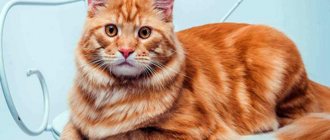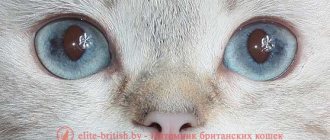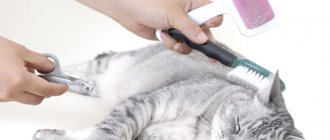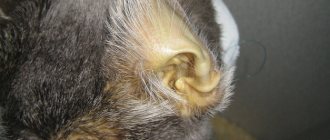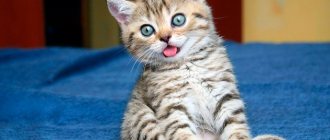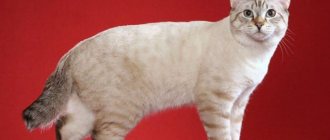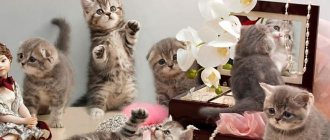Character and disposition
The peculiarity of the formation of the character of furry aristocrats is that they can be educated up to 1 year, maximum up to 1.5 years. Before this age, you need to inculcate the right skills.
Otherwise, you will have to put up with established habits or engage in re-education throughout your life. Here are the main pros and cons of the complex nature of these cats. Advantages:
- only go to the litter box;
- do not spoil things in the house;
- loyal to the owner;
- lenient towards children;
- calm and independent;
- moderately active
- make contact.
Flaws:
- waywardness;
- love themselves;
- stubbornness;
- touchiness;
- rancor.
The character of the British has many more advantages.
Behavior of British cats
The characteristics of shorthaired cats are largely determined by their behavior. The main features are formed before 1 year, and during this period the distinctive features of this breed are:
- activity;
- mobility;
- dexterity;
- ingenuity;
- accuracy;
- swiftness.
They are calmed down by the mother cat: with her licking, she brings them out of the state of overexcitation.
Kittens always try to be like their mother and play out the following situations:
- threat of attack;
- fight;
- meeting with an opponent;
- hunting;
- protection of their offspring.
As Britons mature, they become more humble. They no longer need company to have fun. It will be enough to prepare a special play corner with toys for them. Without this, cats will climb on cabinets, jump on tables and sweep away everything in their path.
Already adults do not particularly need games. Excessive physical activity is replaced by:
- calm;
- phlegm;
- long sleep (up to 20 hours).
This behavior can lead to obesity, so owners should carefully monitor their pet’s diet, not overfeed it, and, if possible, involve it in play.
The British, despite their size and strength, are not adapted to their environment. Once outside, they become helpless and can become prey to other animals. The possibility of infection with various infections and parasites should not be ruled out, so it is not recommended to let them out.
Relationship with the owner
A true Briton is smug and self-sufficient, and views his owners as breadwinners. It is not without reason that this breed is considered suitable for business people. They don't like to sit on their hands and can't stand noisy companies at all.
After a long day of work, the pet will greet the person reverently and tenderly, and will rub against the legs. They don’t like it when the owner stays late somewhere and doesn’t come home from work on time.
The short-haired British aristocrat purrs and purrs only to selected people. Plush pets guard their boundaries and get used only to those who feed and care for them. Only this person will have them sit on his lap.
If there is a child in the family, you should not have a Briton for his entertainment. Representatives of this breed are very patient with children, but they will not allow themselves to be made into toys. They will hide and run away.
It is very rare for a straight-eared Briton to be “tame.” He doesn't often ask to be held and petted. However, when he needs to climb onto his owner’s lap, he will follow along until he achieves his goal.
The main character traits of a British cat
Each animal, regardless of pedigree, has certain traits that are formed while being in the family and communicating with its members. Moreover, any breed is characterized by certain elements of behavior that manifest themselves to a greater or lesser extent. For the British, this means complete equanimity, independence, patience, good nature and a bit of slight stubbornness.
Family cat - British cat
These cats are distinguished by the fact that they can do without human contact for a long time. They feel good alone, will not spoil wallpaper or furniture, go strictly to the litter box, and their favorite pastime is watching life outside the window.
This is why they are loved by those who have to devote a lot of time to work. In this case, the cats will not be offended, and upon the owner’s return they will play with great pleasure or meow in their arms.
Britons can easily fit into families with several children. The cat's patient nature will allow children to involve him in games. The cat will not release its claws and scratch the child unless the baby causes him great pain. And the cat will gladly take part in minor pranks.
The British are curious, they always need to be aware of everything that is happening in the house. They will always be in the thick of things, but at the same time they do not like to be held on your lap or squeezed.
Aristocratic notes in the character of the British
Aristocratism begins to manifest itself in infancy. They love cleanliness, it is not difficult to train them to use the toilet, and watching their mother, they will do daily chores very carefully. By placing a scratching post for kittens in a fairly convenient place, you can train them to sharpen their claws exclusively on it.
For the first couple of months, kittens will be playful and affectionate creatures, who will gradually become real robbers. The period of hostilities and mischief will last 3-4 months, after which the cats will be more sedate.
The British are difficult to train because of their independent character, for this reason you can force a cat to do something only with affection, love and cunning. This type of cat, in most cases, does not respond to the usual “kitty-kitty”; to attract attention, you will need to address it by name and as affectionately as possible.
Compatibility with other animals
What is the character of a British cat, it will be especially interesting to know for those who have other animals in the house. The British get along quite well with other pets - hamsters, dogs, birds. If something doesn’t suit them about their “neighbor,” then this pet will simply be ignored. The British will not stoop to squabbles and fights that could humiliate their noble breed.
Another character trait of these cats is their dislike of closed spaces, for this reason they prefer to keep the doors in their house open all the time. Leaving the room closed and returning home, you can see scratches on the door and a great deal of resentment on your pet’s face.
Raising such a cat is a complete pleasure; you won’t need to yell at him or constantly forbid anything. An innate intelligence and excellent flexibility of thinking can help a Briton quickly learn what the owner wants to achieve from him, and this “miracle” with its presence will delight you every new day.
https://youtube.com/watch?v=C6yuCkpK228
Character of a British cat - description of the breed
People love everything unusual and fabulous, which is why the British cat breed is so attractive. These animals always remain like little teddy bears. In addition to the attractive appearance,…Read more →
Character of a British breed cat
Many pet lovers of all breeds prefer to have British cats. Some value them for their discreet aristocratic appearance, others see them as docile, calm animals...Read more →
What kind of character do British cats have - everyone should know
The Briton is a cat that has such plush short hair and is so loved by cat connoisseurs. This type of breed is one of the most exquisite cats. In the UK...Read more →
Attitude towards other animals
If you already have an animal in the house and you decide to get a British one, then it is very difficult to guess how the relationship will develop. Representatives of this breed have a rather capricious character, everything is very individual.
There are no particular problems with other pets. Relationships can be very good if a British kitten and another cat or dog are taken into the house at the same time. They are still getting used to each other as babies.
Material on the topic: what is the British cat breed.
In the case when an adult is taken into the house, everything depends on how the other animal will treat the representative of the British breed. They really don't like being bothered. It doesn’t matter what kind of pet is next to them in the same apartment. The main thing to maintain calm is to simply not bully or touch them.
Britons usually get along easily with other animals.
Characteristics of the British
Before purchasing a pet of the British cat breed, future owners should know how they differ from ordinary cats, whose breed does not have a prestigious name. There are no representatives of the cat tribe with such a unique character as the British.
The British cat is a real aristocrat. She will not respond to the usual cat call “kitty-kitty” - this is beyond her dignity. The British demand that they be called by name, not recognizing other addresses. The independence of a pet of this breed is an ideal character trait that attracts people who are away from home for a long time.
The British do not get bored alone, but at the same time they do not remain indifferent to their owner, they just do not like to show their feelings. Despite apparent indifference, British cats treat all family members well. They even tolerate the pestering of small children, but if they are hurt, the reaction will be immediate - a blow from sharp claws cannot be avoided. They also get along with the animals in the house.
If a cat doesn’t like something, it rarely shows aggression. Most often, she will hide in a secluded place, harboring a grudge for a long time. However, even a very offended British cat will not stoop to revenge - she will not shit in shoes, as many of her relatives do. The expression on her “face” will perfectly tell about her feelings, on which the resentment will be clearly visible.
It is worth noting the cleanliness of the British. Usually, kittens are taken home at an age when their mother has already taught them to use a litter box. Pet owners can only monitor its cleanliness. If the kitten was adopted as a baby, then it almost instantly learns where its toilet is located.
The Briton cleans his fur coat several times a day. If he is excited about something, he also begins to lick himself - this is a reaction in cats of the British breed to the stress they have experienced. This way they calm down and restore psychological comfort.
Even if a British cat is hungry, she will not meow to remind herself of herself, but will sit next to an empty bowl and will look expressively at her owner. This plush aristocrat considers begging to be undignified behavior. You should know that if a cat doesn’t like food, then you shouldn’t try to feed it unloved food - such an attempt will be unsuccessful.
The British do not tolerate closed doors in the house, considering them a restriction of their freedom. They choose a sleeping place for themselves on a hill, so the best choice when arranging a place for their pet to rest would be to purchase a high cat bed in the form of a house where the pet can retire.
The British spend a lot of time sleeping. Sometimes its duration reaches 20 hours. Therefore, the owner should not worry. If it seems to him that the pet sleeps too long, this is also one of the characteristics of this breed.
Attitude towards children
The presence of cats in the house has a very beneficial effect on the development of children. They create a favorable environment and promote the production of “happiness hormones.” Quite often in families with one child, you can hear complaints from parents that the baby is growing up capricious, spoiled, and misbehaving. A furry pet in the house changes the psyche of children for the better.
The animal partially switches the parents' attention from the child to themselves, reducing the intensity of excessive care. The child may begin to talk to the cat, which will help with speech development. By playing with a pet, children develop fine and gross motor skills.
Some psychologists even argue that having an animal in childhood helps you cope more easily with adolescence, and then in family life. Such children, and subsequently adults, are kind, sociable, and treat others with understanding.
It is believed that cats strengthen the baby's immunity. They bring their own microflora, which the baby will encounter outside the home, and make it possible to resist various diseases.
Parents often worry about their child's allergies. Before adopting a pet, consult your doctor. It is believed that children who grew up with animals are less susceptible to allergies.
Pros of British cats
Before you bring a British cat into your home, you need to carefully weigh everything and study the pros and cons of the British cat breed.
Positive points:
- The British are distinguished by good health , so they do not need greenhouse conditions for living, and they are not afraid of cold snaps in the apartment.
- Cats of this breed are friendly and affectionate , they will easily make contact, but at the same time retaining in their character such traits as stubbornness and reluctance to obey the will of others.
- The British will not avoid contact with dogs, loves children, and will tolerate children's games or pranks for as long as possible before fighting back.
- The owners can easily endure a long absence ; while they are at work, the cat will go about its business: sleep, play, explore the house. But when you come home, you won’t see a mess; even though your pet missed you, he won’t destroy the space around him.
- This breed is easy to care for , so maintaining it will not require much effort, except for the need to brush it to remove the undercoat once a week, and at the time of shedding - daily.
- The British are a very clean breed of cats ; they constantly lick their fur, so in order to avoid clogging the cat’s gastrointestinal tract, it is necessary to give it special medications to resolve hairballs.
- Cats, including British ones, help relieve stress , treat depression in their owners, and also contribute to the psycho-emotional development of children, especially those with severe developmental disorders (cerebral palsy, autism, motor alalia).
Bad habits
Just like people, cats have bad habits. No, they don't smoke or drink alcohol, or even use drugs. They have a different world and other bad habits. As a rule, they take up to a year to form.
British cats can take offense at their owners.
British babies can start biting their hands as early as 4 months. They, like small children at this age, are teething. This problem can be easily solved with special teethers.
The owner's hands will be the favorite teething tool if you don't wean him off this habit in time. Having matured, a British cat can bite constantly.
A Briton can push his owner out of bed.
When a little kitten sleeps in the same bed as its owner, it looks quite cute. The fluffy little ball is snoring peacefully nearby.
But when he grows up, he begins to consider the bed his territory, and sometimes the owner will survive from his own bed. Therefore, while the kitten is small, designate the territory where he is not allowed to go, show acceptable boundaries.
Kittens love to watch things fall from the table, from the bedside table, they will throw away everything that is “badly worth it.” It is necessary to wean the animal from this habit in early childhood. Otherwise, on the floor there will be not only a pencil, but also an expensive telephone, a vase of flowers, dishes and everything that falls cheerfully and loudly.
They treat toys the same way as small children - their interest in them is very short-lived. For a maximum of one day, the fluffy will play with a new entertainment, and then interest disappears, the toy will gather dust in the corner.
To give your kitten toys that don't put a strain on your budget, make them yourself. Pencils, tennis balls, and ping pong balls are suitable for active games.
Nothing can replace personal attention to your pet. Nowadays, we spend a lot of time at the computer. As a break, play with your fluffy fidget, then he will learn to occupy himself independently when his owners are not around.
It is worth getting personal toys for your British cat.
Will it catch mice?
Following from history, British cats were specially bred to catch rats and mice. For successful hunting, breeders wanted to achieve a thick and short coat, so that it would be difficult for rodents to bite and injure the little catcher.
All representatives of this breed catch mice. This is genetically embedded in them. But in city apartments, as a rule, there is no opportunity to hunt at all.
Some owners take their British Shorthair cat with them to the countryside. There they catch all the mice in the area within a week. They most often bring their prey to the owner. When the rodents run out, the hunt begins for frogs, large insects, and birds. Cats are more graceful and passionate in hunting than cats.
The British are born mousecatchers.
Features of behavior
The characteristics of the British determine their habits and habits. Let's look at the behavior in basic terms.
Devotion
We are accustomed to the fact that the palm in loyalty belongs to dogs. According to prevailing stereotypes, it is difficult to imagine such a quality in a cat. Cats are self-sufficient, they are born with this feeling. Since the times of Ancient Egypt, it has been known that cats are connected with the afterlife and bring their special energy into the house. Watch the video, it presents some of the character traits of the British cat breed.
They love to clean the energy field, align it with their owner, and protect the territory from negative energy influences. The British will only be faithful to someone who gives her a lot of positive emotions, plays with them and expresses his love for them.
Patience
This is one of the defining character traits of British cats. They tolerate everything from small children. Little children love to explore the world, touch, stroke, pull the tail and whiskers, and do a lot of unpleasant things to the poor cat. But they steadfastly endure all these medieval tortures, realizing that the child is too small and simply does not understand that an animal can be in pain.
Friendliness
Friendliness is one of the main traits of this breed. They can be friends with everyone. At an early age, they love to play a lot and are active; they can hit someone with their paw while playing. Growing up, they are friends with cats and dogs in equal measure.
Cleanliness
A high degree of cleanliness sets the British apart from the entire cat family. They quickly become accustomed to the litter tray, adopt good manners and lick themselves very thoroughly. Their coat is always clean and tidy, as if they take care of their appearance. By licking themselves, they relieve stress.
Stubbornness
The British will not follow your orders unquestioningly. If they are busy with something, they will not tear themselves away from what they are doing for nothing. They do not tolerate orders, no matter what you say and in what tone.
Breeding the British breed
The first British breed cats were introduced to the public in the 1870s. Breeders from among English gentlemen crossed the aboriginal cats of Great Britain with representatives of other breeds, mainly with Persians. Gradually, the kittens that were born acquired an expressive appearance, good health and tolerance towards all family members.
The popularity of the British grew. However, the Second World War that engulfed Europe destroyed the achievements of felinology, and the new breed of cats, popular at that time, became a rarity. To continue the work, it was necessary to eliminate inbreeding, so animals of other breeds were again used for mating. As a result, pets of new generations began to acquire Persian features.
Now felinological work is carried out within the framework of the accepted breed standard. However, in the bloodlines of different countries, some breed traits can be enhanced. Thus, among American breeders, a powerful, strong physique is valued. And at the European exhibition, the championship will be given to the pet in the most elegant coat.
Characteristic external signs
The British cat has a large, smoothly contoured head with well-defined cheeks. Wide cheekbones further emphasize the shape and fullness of the head. The nose is straight, thick and short, with a smooth transition to a round forehead. The chin is confident and strong, forming a vertical line with the nose.
Small, round, low, wide-set ears emphasize the robust appearance of the animal. The British are especially proud of their eyes: large, widely spaced. They carefully monitor everything that happens around them, even in those moments when the cat lies imposingly on a sun-drenched windowsill.
The pupils are always brightly colored: most are amber-copper, color-points are icy blue, and lilac and blue aristocrats are grass-green.
The massiveness of the silhouette is ensured by a squat body with low strong paws, a powerful chest, pronounced shoulders, and a thick tail. The coat is short, loosely fitting to the body. The entire coat is divided into a thicker coat and a dense undercoat.
Among the representatives of this breed, sexual dimorphism is well expressed. The weight of an adult cat ranges from 5 to 7 kg, of a female cat - from 3 to 5 kg. The average life expectancy is 12 - 15 years. However, from time to time in the media you can hear references to Britons who live to be 20 years or more.
White color and genetic characteristics
The white color of a British cat is characterized by snow-white fur without any inclusions or marks or smoke. In this case, newborn kittens may have a small spot, which should completely disappear by the age of one year.
This shade of fur should be uniform over the entire surface of the body; the presence of yellowness around the eyes, under the tail, and at the paw pads is excluded.
The nose, paw pads, eyelids, and the inner surface of the ears can only be pink. To encode white color, felinologists use the combination BRI W. Their meanings are:
- BRI W 61 - white British kittens with deep, intense blue eyes. Such animals often suffer from congenital deafness, which is transmitted at the genetic level.
- BRI W 63 - heterochromic British cats of white color. One eye of such animals is blue, the other is orange or copper.
- BRI W 64 - snow-white cats with green eyes.
- BRI W 62 - white color of British cats with orange eyes.
The W gene is responsible for the white coat color. Being dominant, it suppresses the genes of other colors present in the animal’s genetic makeup. It also determines the shade of the iris. As a result of blocking the pigment accumulation process, both eyes remain blue.
Also, the blue color can remain in only one eye, while the other eye is colored copper or orange by melanin. Occasionally, partial heterochromia occurs, in which two contrasting shades are combined in one cornea.
Such genetic combinations are “exclusive”, which is why heterochromic Britons are usually called “royal cats”, which are credited with the ability to bring good luck and prosperity to the home.
The principles of breeding within the British breed prohibit the mating of two individuals of the “BRI W” color. In this way, congenital deafness, which is transmitted by the dominant “W” gene, is prevented.
